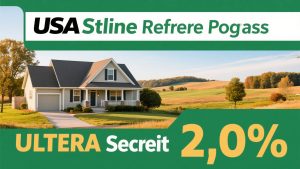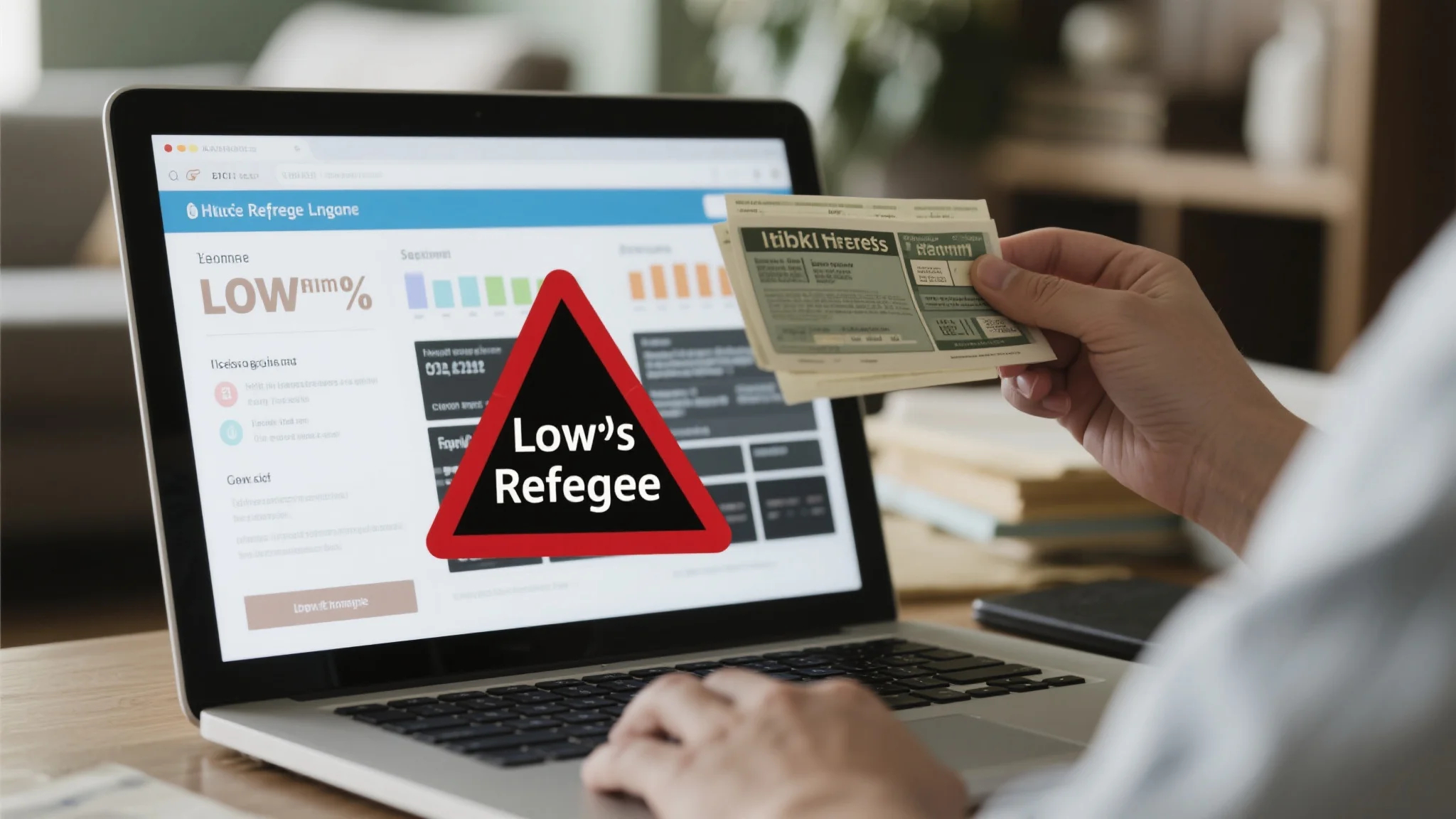Rural homeowners across America have access to one of the most underutilized yet powerful refinancing tools available in today’s mortgage market: the USDA streamline refinance program. This specialized refinancing option, designed specifically for properties in USDA-eligible rural and suburban areas, offers homeowners the opportunity to secure exceptionally competitive interest rates while bypassing many of the traditional barriers associated with conventional refinancing. Unlike standard mortgage refinancing programs that require extensive documentation, new appraisals, and lengthy approval processes, USDA streamline refinancing provides a simplified pathway to lower monthly payments and reduced interest costs. The program’s unique structure allows qualified borrowers to refinance their existing USDA Rural Development loans with minimal paperwork and faster processing times, making it an attractive option for homeowners seeking immediate financial relief.
Unlocking the Power of USDA’s Simplified Refinancing Process
The USDA streamline refinance program operates under fundamentally different principles than conventional refinancing options, creating opportunities for rural homeowners that simply don’t exist in traditional mortgage markets. The streamlined nature of this program eliminates many of the costly and time-consuming requirements that typically accompany refinancing transactions. Borrowers don’t need to undergo new credit checks, provide updated income documentation, or obtain fresh property appraisals in most cases. This streamlined approach not only reduces the overall cost of refinancing but also significantly shortens the timeline from application to closing, often completing transactions in as little as 30 days compared to the 45-60 day timeline typical of conventional refinancing.
The eligibility requirements for USDA streamline refinancing are designed to be accessible while maintaining the program’s integrity and purpose. Homeowners must currently have a USDA Rural Development loan that has been in good standing, typically requiring at least 12 months of on-time payments before becoming eligible for streamline refinancing. The property must continue to meet USDA rural designation requirements, though these areas are more extensive than many homeowners realize, encompassing not just traditional rural communities but also many suburban areas outside major metropolitan centers. The program’s geographic scope covers approximately 97% of the United States’ land area, including communities with populations up to 35,000 residents in some cases.
One of the most compelling aspects of rural refinance programs like the USDA streamline option is their ability to provide immediate financial benefits without the typical refinancing costs. The program allows for the inclusion of closing costs in the loan amount, meaning homeowners can achieve lower monthly payments without bringing cash to the closing table. This feature is particularly valuable for rural homeowners who may have limited liquid savings but substantial equity in their properties. The interest rate reductions available through the program can be substantial, often ranging from 0.5% to 2% below current market rates, depending on the borrower’s existing loan terms and current market conditions.
The documentation requirements for USDA streamline refinancing represent a significant departure from conventional mortgage processes. Borrowers typically need only provide basic identification, proof of homeowners insurance, and verification of their current mortgage payment history. The absence of income verification requirements means that homeowners who have experienced changes in employment or income since their original loan approval can still qualify for refinancing, provided they’ve maintained their payment history. This flexibility is particularly valuable for rural homeowners whose income may fluctuate seasonally or who work in agricultural or other industries common in rural areas.
The program’s structure also accommodates various loan modification scenarios that can benefit different types of borrowers. Homeowners can choose between rate-and-term refinancing, which focuses solely on improving interest rates and loan terms, or cash-out refinancing options that allow them to access their home’s equity for other purposes. The cash-out option is particularly attractive for rural homeowners looking to fund property improvements, consolidate higher-interest debt, or invest in agricultural or business opportunities. The program’s flexible approach to loan-to-value ratios often allows for cash-out refinancing up to 100% of the property’s current value, providing substantial access to equity that might not be available through conventional refinancing programs.
Achieving Ultra-Low Interest Rates Through Strategic Program Utilization
The pursuit of ultra low mortgage rates through USDA streamline refinancing requires understanding the program’s unique pricing structure and timing strategies that can maximize interest rate benefits. USDA’s government backing allows lenders to offer rates that are often 0.25% to 0.75% below conventional mortgage rates, creating immediate savings opportunities for qualified borrowers. These rate advantages stem from the reduced risk profile that government guarantees provide to lenders, allowing them to pass along savings in the form of lower interest rates. The program’s streamlined underwriting process also reduces lender costs, which can translate into additional rate improvements for borrowers.
Market timing plays a crucial role in maximizing the benefits of USDA streamline refinancing, as interest rate environments can significantly impact the potential savings available through the program. During periods of declining interest rates, the streamlined process allows rural homeowners to capitalize on market improvements more quickly than conventional refinancing would permit. The reduced documentation and faster processing times mean that borrowers can lock in favorable rates before market conditions change, providing a competitive advantage over traditional refinancing approaches. Conversely, during rising rate environments, the program’s efficiency allows homeowners to secure refinancing before rates climb further, protecting them from future increases.
The relationship between loan terms and interest rate optimization creates additional opportunities for strategic refinancing decisions. USDA streamline refinancing allows borrowers to adjust their loan terms as part of the refinancing process, potentially moving from 30-year to 15-year terms to achieve even lower interest rates while building equity more rapidly. This flexibility enables homeowners to align their mortgage terms with their financial goals and life circumstances. For example, borrowers approaching retirement might choose shorter terms to eliminate mortgage payments before their income decreases, while younger homeowners might prioritize lower monthly payments through longer terms.
The program’s approach to mortgage insurance also contributes to its overall cost-effectiveness and rate competitiveness. USDA loans require an upfront guarantee fee and an annual fee, but these costs are often lower than the private mortgage insurance required on conventional loans with less than 20% down payment. For streamline refinancing, the upfront fee may be reduced or waived entirely in some cases, further improving the program’s cost-effectiveness. The annual fee structure is typically more favorable than PMI, particularly for borrowers with lower down payments or those who haven’t yet reached 20% equity in their homes.
Advanced strategies for rate optimization include considering the timing of refinancing relative to the borrower’s existing loan’s amortization schedule. Homeowners who refinance early in their loan term can maximize the interest savings over the remaining loan period, while those later in their amortization schedule might focus on term reduction strategies. The program’s flexibility allows for customized approaches that align with individual financial circumstances and goals. Some borrowers may benefit from multiple refinancing transactions over time as market conditions change, taking advantage of the streamlined process to continuously optimize their mortgage terms.
The competitive landscape among USDA-approved lenders creates additional opportunities for rate shopping and negotiation. While the program’s standardized structure limits some variation in terms, lenders may offer different pricing on optional services, closing costs, or processing fees. Rural homeowners should obtain quotes from multiple USDA-approved lenders to ensure they’re receiving the most competitive overall package. The streamlined nature of the program makes this comparison process more straightforward than conventional mortgage shopping, as the core loan terms are largely standardized across participating lenders.
Maximizing Long-Term Financial Benefits Through Strategic Program Implementation
The long-term financial impact of rural refinance programs extends far beyond immediate monthly payment reductions, creating opportunities for wealth building and financial security that can transform rural homeowners’ economic prospects. The combination of lower interest rates, reduced fees, and flexible terms available through USDA streamline refinancing can generate substantial savings over the life of the loan. For example, a homeowner who reduces their interest rate by 1% on a $200,000 mortgage can save approximately $40,000 in interest payments over a 30-year term, while also reducing their monthly payment by roughly $200. These savings can be redirected toward other financial goals, such as retirement savings, education funding, or property improvements that further enhance the home’s value.
The equity building advantages of ultra low mortgage rates achieved through USDA streamline refinancing create compounding benefits over time. Lower interest rates mean that a larger portion of each monthly payment goes toward principal reduction rather than interest expense, accelerating equity accumulation. This faster equity building provides homeowners with increased financial flexibility and security, creating opportunities for future borrowing against home equity or providing a larger asset base for retirement planning. Rural homeowners, who may have fewer investment options available in their local markets, can benefit significantly from this accelerated equity building as a wealth accumulation strategy.
The program’s impact on overall debt management and financial health extends beyond the mortgage itself. The monthly payment reductions achieved through streamline refinancing can free up cash flow for other debt reduction strategies, emergency fund building, or investment opportunities. Rural homeowners often face unique financial challenges, including seasonal income variations, limited local employment opportunities, and higher transportation costs. The improved cash flow from lower mortgage payments can provide crucial financial flexibility to navigate these challenges while building long-term financial security.
Strategic use of cash-out refinancing options within the USDA streamline program can fund improvements that enhance both property value and quality of life. Rural properties often offer opportunities for value-adding improvements such as energy efficiency upgrades, agricultural facilities, or home-based business infrastructure. The program’s favorable terms for cash-out refinancing make these investments more accessible and financially viable. Energy efficiency improvements, in particular, can provide ongoing savings that complement the mortgage payment reductions, creating multiple layers of financial benefit.
The tax implications of USDA streamline refinancing can provide additional financial advantages that enhance the program’s overall value proposition. Mortgage interest remains tax-deductible for most homeowners, and the lower interest rates achieved through refinancing can optimize this deduction while reducing overall borrowing costs. For rural homeowners who may have agricultural income or home-based businesses, the mortgage interest deduction can be particularly valuable as part of broader tax planning strategies. Additionally, any points paid as part of the refinancing process may be deductible, further improving the transaction’s tax efficiency.
The program’s flexibility regarding future refinancing creates opportunities for ongoing optimization as market conditions and personal circumstances change. Unlike some government programs that limit refinancing frequency, USDA streamline refinancing can be utilized multiple times, allowing homeowners to continuously adapt their mortgage terms to changing conditions. This flexibility is particularly valuable in volatile interest rate environments, where multiple refinancing transactions might be beneficial over the life of homeownership. The streamlined process makes these future transactions more feasible and cost-effective than conventional refinancing would allow.
Risk management considerations also favor the USDA streamline refinancing approach for rural homeowners. The program’s government backing provides stability and predictability that can be particularly valuable in rural markets, which may be more susceptible to economic volatility than urban areas. The fixed-rate options available through the program protect borrowers from future interest rate increases, providing payment stability that supports long-term financial planning. For rural homeowners whose income may be tied to agricultural cycles or other variable factors, this payment predictability can be crucial for financial security and planning.




